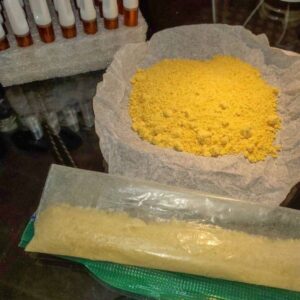5-CL-ADB-A
$210.00 – $2,455.00
Description
5-CL-ADB-A: A Comprehensive Guide to a Potent Synthetic Cannabinoid
Introduction
5-CL-ADB-A is a synthetic cannabinoid that has gained attention for its potent effects and is primarily used for research purposes. This compound is a derivative of indazole-based synthetic cannabinoids and is known for its strong interaction with the endocannabinoid system, making it a subject of interest for researchers studying its pharmacological properties. In this article, we’ll delve into what 5-CL-ADB-A is, its potential uses, safety considerations, and why it’s important to approach this substance with caution.
What is 5-CL-ADB-A?
5-CL-ADB-A, also known as 5-Chloro-ADB-A, is a synthetic cannabinoid that mimics the effects of naturally occurring cannabinoids like THC (tetrahydrocannabinol). It is part of a class of designer drugs that are often used in scientific research to explore the interaction between cannabinoids and the body’s endocannabinoid system. Unlike naturally occurring cannabinoids, synthetic cannabinoids like 5-CL-ADB-A are lab-created and can have much stronger effects, making them useful for studying the cannabinoid receptors in the brain and body.
Key Features and Properties of 5-CL-ADB-A
- High Potency: 5-CL-ADB-A is known for its high potency, which means it can produce strong effects even at low doses. This makes it a valuable tool in research settings for studying the effects of cannabinoids.
- Chemical Structure: 5-CL-ADB-A belongs to the indazole-3-carboxamide family, which is known for its ability to bind strongly to cannabinoid receptors, particularly CB1 and CB2 receptors.
- Research Use: The primary use of 5-CL-ADB-A is in scientific research, where it helps researchers understand how synthetic cannabinoids interact with the endocannabinoid system and the potential therapeutic or adverse effects they may produce.
- Legal Status: Like many synthetic cannabinoids, the legal status of 5-CL-ADB-A varies by country and region. It is often controlled under analog acts or specific regulations due to its structural similarity to other regulated synthetic cannabinoids.
How 5-CL-ADB-A Works
5-CL-ADB-A works by binding to the cannabinoid receptors in the brain and body, particularly the CB1 and CB2 receptors. These receptors are part of the endocannabinoid system, which plays a crucial role in regulating various physiological processes, including mood, appetite, pain sensation, and immune response. Because 5-CL-ADB-A has a high affinity for these receptors, it can produce effects that are much stronger than those of natural cannabinoids like THC.
- CB1 Receptors: These receptors are primarily found in the brain and are responsible for the psychoactive effects of cannabinoids. 5-CL-ADB-A’s interaction with CB1 receptors can lead to altered mental states, mood changes, and other central nervous system effects.
- CB2 Receptors: Found mostly in the immune system and peripheral organs, CB2 receptors are associated with anti-inflammatory effects. 5-CL-ADB-A’s binding to these receptors may influence immune response and inflammation.
Potential Uses and Applications
While 5-CL-ADB-A is primarily used in research, its potent effects make it a compound of interest for studying various aspects of cannabinoid pharmacology, including:
- Therapeutic Potential: Researchers are exploring the potential therapeutic uses of synthetic cannabinoids, including their role in pain management, inflammation reduction, and neuroprotection.
- Pharmacokinetics: Studies on 5-CL-ADB-A can help scientists understand how synthetic cannabinoids are absorbed, distributed, metabolized, and excreted in the body.
- Safety and Toxicity: Research on 5-CL-ADB-A also focuses on identifying potential risks, including toxicity and adverse effects, which are critical for understanding the safety profile of synthetic cannabinoids.
Safety and Precautions
Given the high potency of 5-CL-ADB-A, it is essential to handle this compound with care:
- For Research Use Only: It is not intended for human consumption and should only be used in controlled research settings.
- Proper Handling: Researchers should use appropriate safety equipment and procedures when working with 5-CL-ADB-A to avoid accidental exposure.
- Legal Considerations: Ensure compliance with local regulations and laws regarding the use and possession of synthetic cannabinoids like 5-CL-ADB-A.
- Health Risks: Due to its potency, it may pose significant health risks if misused. Symptoms of overdose or toxicity can include severe anxiety, agitation, hallucinations, and cardiovascular issues.
Conclusion
It is a potent synthetic cannabinoid that plays a significant role in cannabinoid research. Its ability to strongly interact with the endocannabinoid system makes it a valuable tool for studying the pharmacological effects of cannabinoids. However, due to its high potency and potential risks, it should only be used in controlled research environments. As synthetic cannabinoids continue to be a focus of scientific study, compounds like 5-CL-ADB-A provide critical insights into the complex interactions between cannabinoids and the human body.
Additional information
| choose an option | 10g, 25g, 50g, 100g, 250g, 500g, 1kg |
|---|






Reviews
There are no reviews yet.